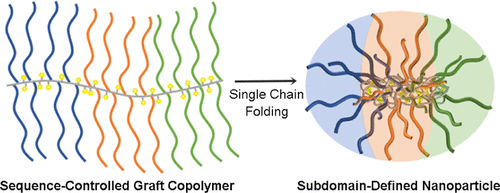当前位置:
X-MOL 学术
›
Macromolecules
›
论文详情
Our official English website, www.x-mol.net, welcomes your feedback! (Note: you will need to create a separate account there.)
Folding of Sequence-Controlled Graft Copolymers to Subdomain-Defined Single-Chain Nanoparticles
Macromolecules ( IF 5.5 ) Pub Date : 2021-09-17 , DOI: 10.1021/acs.macromol.1c01674 Jiyun Nam 1 , Sangwoo Kwon 2 , Yong-Guen Yu 3 , Ho-Bin Seo 3 , Jae-Suk Lee 3 , Won Bo Lee 2 , YongJoo Kim 4 , Myungeun Seo 1, 5
Macromolecules ( IF 5.5 ) Pub Date : 2021-09-17 , DOI: 10.1021/acs.macromol.1c01674 Jiyun Nam 1 , Sangwoo Kwon 2 , Yong-Guen Yu 3 , Ho-Bin Seo 3 , Jae-Suk Lee 3 , Won Bo Lee 2 , YongJoo Kim 4 , Myungeun Seo 1, 5
Affiliation

|
We developed a methodology, inspired by the folding of proteins, for the precision synthesis of hairy polymer nanoparticles. High-molar mass and narrowly dispersed graft copolymers were synthesized by graft-through ring opening metathesis polymerization, to incorporate a designated number of side chains and dimerizable cinnamic acid groups. Intrachain photodimerization collapsed the backbone and arrested it into a compact globular conformation, resulting in hairy nanoparticles topologically equivalent to a core cross-linked star polymer. The single-chain collapse process translates the molecular information written on the 1D graft copolymer into the 3D globular polymer nanoparticle, like protein folding. Unprecedented control over structural parameters was achieved, including the length, number, and composition of the side chains as well as cross-linking density. Different side chains formed distinct subdomains in the sterically congested nanoparticle state and further self-assembled into micellar aggregates in a selective solvent. Both experimental observations and computational simulations indicated that preorganization of the side chains in the block sequence produces subdomains which primarily follow the backbone length scale, while random sequences showed side chain-dependent scaling. Polymer nanoparticles with discrete multiple subdomains were produced by folding of the ternary block graft copolymers. Drastic differences in the self-assembly behavior of ABC- and ACB-sequenced nanoparticles indicate that the spatial organization of subdomains can be achieved by sequence control.
中文翻译:

序列控制的接枝共聚物折叠成亚域定义的单链纳米粒子
我们开发了一种受蛋白质折叠启发的方法,用于精确合成多毛聚合物纳米粒子。高摩尔质量和窄分散的接枝共聚物是通过接枝开环复分解聚合合成的,以结合指定数量的侧链和二聚肉桂酸基团。链内光二聚化使主链塌陷并将其捕获为紧凑的球状构象,从而产生拓扑上等效于核心交联星形聚合物的毛状纳米粒子。单链坍缩过程将写在 1D 接枝共聚物上的分子信息转化为 3D 球状聚合物纳米颗粒,如蛋白质折叠。实现了对结构参数的前所未有的控制,包括长度、数量、和侧链的组成以及交联密度。不同的侧链在空间拥挤的纳米粒子状态下形成不同的子域,并在选择性溶剂中进一步自组装成胶束聚集体。实验观察和计算模拟都表明,块序列中侧链的预组织产生了主要遵循主链长度尺度的子域,而随机序列显示出侧链相关的尺度。通过折叠三元嵌段接枝共聚物产生具有离散多个子域的聚合物纳米粒子。ABC 和 ACB 测序的纳米粒子自组装行为的巨大差异表明子域的空间组织可以通过序列控制来实现。不同的侧链在空间拥挤的纳米粒子状态下形成不同的子域,并在选择性溶剂中进一步自组装成胶束聚集体。实验观察和计算模拟都表明,块序列中侧链的预组织产生了主要遵循主链长度尺度的子域,而随机序列显示出侧链相关的尺度。通过折叠三元嵌段接枝共聚物产生具有离散多个子域的聚合物纳米粒子。ABC 和 ACB 测序的纳米粒子自组装行为的巨大差异表明子域的空间组织可以通过序列控制来实现。不同的侧链在空间拥挤的纳米粒子状态下形成不同的子域,并在选择性溶剂中进一步自组装成胶束聚集体。实验观察和计算模拟都表明,块序列中侧链的预组织产生了主要遵循骨架长度尺度的子域,而随机序列显示出侧链相关的尺度。通过折叠三元嵌段接枝共聚物产生具有离散多个子域的聚合物纳米粒子。ABC 和 ACB 测序的纳米粒子自组装行为的巨大差异表明子域的空间组织可以通过序列控制来实现。
更新日期:2021-09-28
中文翻译:

序列控制的接枝共聚物折叠成亚域定义的单链纳米粒子
我们开发了一种受蛋白质折叠启发的方法,用于精确合成多毛聚合物纳米粒子。高摩尔质量和窄分散的接枝共聚物是通过接枝开环复分解聚合合成的,以结合指定数量的侧链和二聚肉桂酸基团。链内光二聚化使主链塌陷并将其捕获为紧凑的球状构象,从而产生拓扑上等效于核心交联星形聚合物的毛状纳米粒子。单链坍缩过程将写在 1D 接枝共聚物上的分子信息转化为 3D 球状聚合物纳米颗粒,如蛋白质折叠。实现了对结构参数的前所未有的控制,包括长度、数量、和侧链的组成以及交联密度。不同的侧链在空间拥挤的纳米粒子状态下形成不同的子域,并在选择性溶剂中进一步自组装成胶束聚集体。实验观察和计算模拟都表明,块序列中侧链的预组织产生了主要遵循主链长度尺度的子域,而随机序列显示出侧链相关的尺度。通过折叠三元嵌段接枝共聚物产生具有离散多个子域的聚合物纳米粒子。ABC 和 ACB 测序的纳米粒子自组装行为的巨大差异表明子域的空间组织可以通过序列控制来实现。不同的侧链在空间拥挤的纳米粒子状态下形成不同的子域,并在选择性溶剂中进一步自组装成胶束聚集体。实验观察和计算模拟都表明,块序列中侧链的预组织产生了主要遵循主链长度尺度的子域,而随机序列显示出侧链相关的尺度。通过折叠三元嵌段接枝共聚物产生具有离散多个子域的聚合物纳米粒子。ABC 和 ACB 测序的纳米粒子自组装行为的巨大差异表明子域的空间组织可以通过序列控制来实现。不同的侧链在空间拥挤的纳米粒子状态下形成不同的子域,并在选择性溶剂中进一步自组装成胶束聚集体。实验观察和计算模拟都表明,块序列中侧链的预组织产生了主要遵循骨架长度尺度的子域,而随机序列显示出侧链相关的尺度。通过折叠三元嵌段接枝共聚物产生具有离散多个子域的聚合物纳米粒子。ABC 和 ACB 测序的纳米粒子自组装行为的巨大差异表明子域的空间组织可以通过序列控制来实现。


























 京公网安备 11010802027423号
京公网安备 11010802027423号